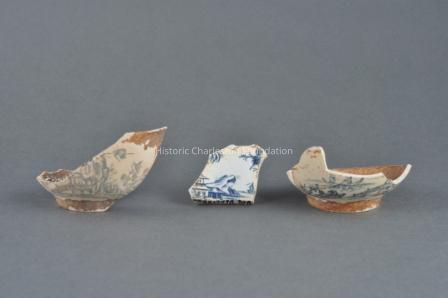Teabowl fragments
Name/Title
Teabowl fragmentsEntry/Object ID
L.2011.009.1-3Description
John Bartlam (English-born, working in Cain Hoy, SC, 1765-1783) Teabowl fragments Cain Hoy, SC, ca. 1765/1769 Soft-paste porcelain with transfer-printed decoration A-90A: H. 1 1/4 (widest) x W. 1 1/2 inches (widest); A-90B/E: H. 1 5/8 (widest) x W. 3 inches (widest); A-90A: H. 1 3/8 (widest) x W. 2 5/8 inches (widest) Lent by South Carolina Institute of Archaeology and Anthropology, Columbia, SC, 388K1349A-90A, 388K1349A-90B/E, and 388K1349A-90A John Bartlam (English-born, working in Cain Hoy, SC, 1765-1783) Teabowl Cain Hoy, SC, ca. 1765/1769 Soft-paste porcelain with transfer-printed decoration H. 1 5/8 x Diam. 2 7/8 inches Lent by Chipstone Foundation, Milwaukee, WI, 2010.5 The history of American ceramics is a tale of immigration, adaptation and experimentation. In the 1730s, Andrew Duche's discovery of "Carolina Clay" led to his experimental production of porcelain in Charleston. While no physical evidence of Duche's endeavors has ever come to light, his work may have paved the way for immigrant Staffordshire potter John Bartlam, who came to the Charleston area in 1763 to manufacture British style creamware. Unknown to ceramics historians until recently, John Barltam also made soft-paste porcelain. In the early 1990s, archaeologist Stanley South and historian Brad Rauschenberg uncovered fragments of blue decorated porcelain at Bartlam's Cain Hoy site, just north of Charleston, where he worked from 1765 to 1769. These fragments, three of which are seen here, indicated that Bartlam was successfully producing porcelain several years prior to the well-established manufactory of Gousse Bonnin (1741-ca. 1779) and George Robert Morris (1742/5-1773) in Philadelphia. The newly discovered teabowl, exhibited for the first time in this exhibition, represents the only known surviving intact example of this highly important southern porcelain. Initial scientific analysis confirms that the paste and glaze are identical to the composition of the archaeological sherds. Of particular interest is the interior image of a tree on a rock, which several scholars have noted as similar to a palmetto tree, a well-known South Carolina symbol. The importance of this early southern ceramic object cannot be overstated and additional research sponsored by the Chipstone Foundation is underway to learn more about the entirety of Bartlam's South Carolina enterprise. RHMade/Created
Artist
John Bartlam (English-born, working in Cain Hoy, 1765-1783)Date made
1765 - 1769Lexicon
Nomenclature 4.0
Nomenclature Secondary Object Term
SherdNomenclature Primary Object Term
FragmentNomenclature Category
Category 10: Unclassifiable ObjectsLocation
Location
Building
NR 303 C2Category
PermanentDate
February 7, 2023Exhibitions
10
16

